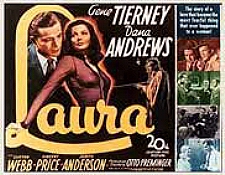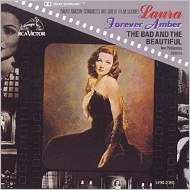 Perhaps the classic example of the fetishizing of women via music (among other things) can be found in Otto Preminger's 1944 Laura. First and foremost, the monothematic nature of Laura's musical score by David Raksin strongly contributes to the obsessive atmosphere built up around the film's heroine, Laura Hunt (Gene Tierney). Almost every piece of music heard in the film either is David Raksin's mysteriously chromatic fox-trot tune or else grows out of it, particularly in the backing score. The detective (Dana Andrews) investigating Laura's murder turns on a phonograph: it plays "Laura." The detective and the prissy radio journalist (Clifton Webb) go to a cafe: a small combo is playing "Laura." The journalist throws a party: the background music is "Laura." But the way in which the melody travels back and forth between the story and the backing score, making that distinction all but meaningless, likewise reinforces the overall obsessiveness.
Perhaps the classic example of the fetishizing of women via music (among other things) can be found in Otto Preminger's 1944 Laura. First and foremost, the monothematic nature of Laura's musical score by David Raksin strongly contributes to the obsessive atmosphere built up around the film's heroine, Laura Hunt (Gene Tierney). Almost every piece of music heard in the film either is David Raksin's mysteriously chromatic fox-trot tune or else grows out of it, particularly in the backing score. The detective (Dana Andrews) investigating Laura's murder turns on a phonograph: it plays "Laura." The detective and the prissy radio journalist (Clifton Webb) go to a cafe: a small combo is playing "Laura." The journalist throws a party: the background music is "Laura." But the way in which the melody travels back and forth between the story and the backing score, making that distinction all but meaningless, likewise reinforces the overall obsessiveness.
The music backing the film's first two sequences is obviously not part of the story: behind the titles, a full orchestra plays a straight version of "Laura," [mp3] with the strings often carrying the melody, that ends (typically for Hollywood) on a suspension in the middle of a phrase and segues into the opening action in which the melody undergoes characteristic film-music modifications to moodily back up the opening visuals and the journalist's voice-over narration. The third musical cue occurs when the detective turns on the radio in the dead Laura's apartment in the presence of the journalist and Laura's fiance (Vincent Price). The music, once again, offers the "Laura" theme. As if it were not enough for the music to have stepped down from the music track into the picture itself, Laura's fiance fortifies its presence within the film by commenting that the tune "was one of Laura's favorites. Not exactly classical, but sweet."
Later on, as the detective and the journalist sit in a restaurant, a combo is playing "Laura"; but the same theme rises back to the music track in a full-orchestra version as the narrative flashes back to the journalist's reminiscences of his early encounters with the heroine, which include very Vertigo-like manipulations of her physical appearance: "Laura had innate breeding, but she deferred to my judgement and taste. I selected a more attractive hair dress for her. I taught her what clothes were more becoming to her." In a word, the "Laura" theme not only obsessively asserts itself to the exclusion of just about any other music in the film, it seems to be omnipresent. It also refuses to allow the audience to settle comfortably into understanding what music is only on the backing score and which is in the story itself.
Indeed, the film fetishizes its heroine's presence from the very outset. Visually complementing the "Laura" theme in the title sequence is a large portrait of Laura (or of Gene Tierney, who immediately lends her fetishized, star status to Laura, since the audience does not even know the character yet) that will dominate a number of the shots in the sequences in Laura's appartment throughout the film. Not only do the portrait and the fox-trot tune offer idealized versions that replace the physical being of the absent heroine, who is not allowed to become "real" for the moment.
The ensuing sequence carries fetishism to mind-boggling extremes: the camera tracks through the apartment of Waldo Lydecker, the journalist, where all human, physical presence is for the moment replaced by numerous objets d'art and by David Raksin's musical backing, which renders the "Laura" tune more obsessive by keeping its second four bars, which are essentially identical to the first four, in the same key, rather than allowing them the step-down modulation already established in the truncated song version of the title music. On the voice track, Clifton Webb's voice offers a narration that begins, "I shall never forget the weekend Laura died."
--ROYAL S. BROWN, from Overtones and
Undertones: Reading Film Music.

